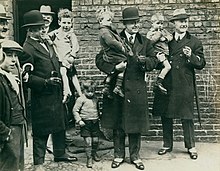
Urban renewal is a program of land redevelopment often used to address urban decay in cities. Urban renewal involves the clearing out of blighted areas in inner cities to clear out slums and create opportunities for higher class housing, businesses, and other developments. In the United States the term technically refers only to a federal program in the middle-to-late 20th Century, but colloquially is sometimes used to refer to any large-scale change in urban development.
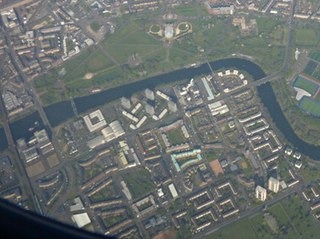
Hutchesontown is an inner-city area in Glasgow, Scotland. Mostly residential, it is situated directly south of the River Clyde and forms part of the wider historic Gorbals district, which is covered by the Southside Central ward under Glasgow City Council.

Back-to-backs are a form of terraced houses in the United Kingdom, built from the late 18th century through to the early 20th century in various forms. Many thousands of these dwellings were built during the Industrial Revolution for the rapidly increasing population of expanding factory towns. Back-to-backs share party walls on two or three of their four sides, with the front wall having the only door and windows.
The Housing Market Renewal Initiative (HMRI) or Housing Market Renewal (HMR) Pathfinders programme was a controversial scheme of demolition, refurbishment and new-building which ran in the UK between 2002 and 2011 and aimed "to renew failing housing markets in nine designated areas of the North and Midlands of England."
The Atlanta Housing Authority (AHA) is an agency that provides affordable housing for low-income families in Atlanta. Today, the AHA is the largest housing agency in Georgia and one of the largest in the United States, serving approximately 50,000 people.

The American Housing Act of 1949 was a landmark, sweeping expansion of the federal role in mortgage insurance and issuance and the construction of public housing. It was part of President Harry Truman's program of domestic legislation, the Fair Deal.

An overspill estate is a housing estate planned and built for the housing of excess population in urban areas, both from the natural increase of population and often in order to rehouse people from decaying inner city areas, usually as part of the process of slum clearance. They were created on the outskirts of most large British towns and during most of the 20th century, with new towns being an alternative approach outside London after World War II. The objective of this was to bring more economic activity to these smaller communities, whilst relieving pressure on overpopulated areas of major cities. The Town Development Act 1952 encouraged the expansion of neighbouring urban areas rather than the creation of satellite communities. The authorities wished to divert people living in poor conditions within highly populous cities to better conditions on the outskirts of these cities. Overspill not only involves moving people to a new area, but requires industry and employment to follow. Often the industries and resources took longer to migrate than the people, hence there were a number of issues surrounding early overspill projects. Slum clearance tenants often had problems with the move, since it separated them from extended family and friends, needed services were often lacking, and only the better off workers could afford the extra cost of commuting back to their jobs. Another criticism was that the new estates occupied what had been productive agricultural land.

The Carlton Association was a community action group that campaigned on behalf of residents of the suburb of Carlton in Melbourne, Australia, between the years 1969 and 1993. The group was involved in protests against some of the most controversial redevelopment plans in the city’s history and was arguably the most politically successful residents’ action group that Melbourne has seen.

Public housing in the United Kingdom, also known as council housing or social housing, provided the majority of rented accommodation until 2011 when the number of households in private rental housing surpassed the number in social housing. Dwellings built for public or social housing use are built by or for local authorities and known as council houses. Since the 1980s non-profit housing associations became more important and subsequently the term "social housing" became widely used, as technically council housing only refers to housing owned by a local authority, though the terms are largely used interchangeably.

Terraced houses have been popular in the United Kingdom, particularly England and Wales, since the 17th century. They were originally built as desirable properties, such as the townhouses for the nobility around Regent's Park in central London, and the Georgian architecture that defines the World Heritage Site of Bath.
A pre-regulation terraced house is a type of dwelling constructed before Public Health Act 1875. It is a type of British terraced house at the opposite end of the social scale from the aristocratic townhouse, built as cheap accommodation for the urban poor of the Industrial Revolution. The term usually refers to houses built in the century before the 1875 Act, which imposed a duty on local authorities to regulate housing by the use of byelaws. Subsequently, all byelaw terraced housing was required to meet minimum standards of build quality, ventilation, sanitation and population density. Almost all pre-regulation terraced housing has been demolished through successive waves of slum clearance.

The Housing Act 1930 otherwise known as the Greenwood Act, is an Act of Parliament in the United Kingdom. It encouraged mass slum clearance and councils to set to work to demolish poor quality housing and replace it with new build. Subsidies for general housing, were given, these were calculated on the number of people rehoused not the number of properties demolished. 'Back to back' housing had finally ended.
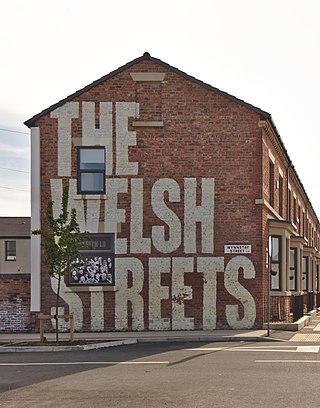
The Welsh Streets are a group of late 19th century Victorian terraced streets in Toxteth, Liverpool, England. The houses were designed by Welsh architect Richard Owens and built by Welsh workers to house migrants from Wales; the streets were named after Welsh villages and landmarks. The Beatles drummer Ringo Starr lived the first few years of his life in Madryn Street. Although some original houses were lost in World War II bombing, many of the terraced properties in the original street configuration remain in the present day.

The Granby Four Streets is an area in Toxteth, Liverpool, England, comprising four streets at the tip of a triangle near the Grade II* listed Princes Park. The streets, designed by Welsh architect Richard Owens and built by Welsh workers during the late 19th century are Beaconsfield Street, Cairns Street, Jermyn Street and Ducie Street. A fifth street, Granby Street, connects the four streets together and mostly contains commercial units.

The Housing Act 1969 is an act of Parliament in the United Kingdom that provided grants to home owners and landlords to improve the quality of their housing and to help finance local authorities to improve the quality of housing stock under their control.
The city of Liverpool in Merseyside, England includes a diverse variety of historical housing architectures, some dating back several hundred years, from small working class terrace houses to larger mansions, mostly from the Victorian era. While many remain in the present day, large numbers were demolished and redeveloped during the slum clearances of the 1960s and 1970s and of those that survived, many have since been refurbished.
Slum clearance in India is used as an urban renewal approach to redevelop and transform poor and low income settlements into new developments or housing. Millions of people live in slum dwellings across India and many migrate to live in the slums from rural villages, often in search of work opportunities. Houses are typically built by the slum dwellers themselves and violence has been known to occur when developers attempt to clear the land of slum dwellings.
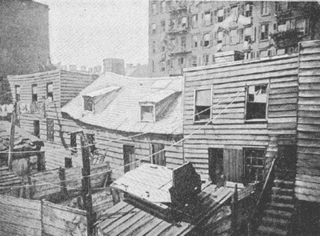
Slum clearance in the United States has been used as an urban renewal strategy to regenerate derelict or run-down districts, often to be replaced with alternative developments or new housing. Early calls were made during the 19th century, although mass slum clearance did not occur until after World War II with the introduction of the Housing Act of 1949 which offered federal subsidies towards redevelopments. The scheme ended in 1974 having driven over 2,000 projects with costs in excess of $50 billion.
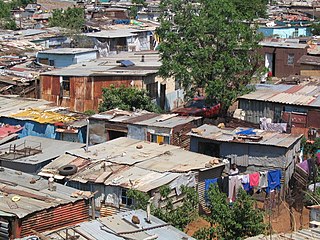
Slum clearance in South Africa has been used as an urban renewal strategy to regenerate derelict or run-down districts, often to be replaced with alternative developments or new housing.

